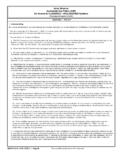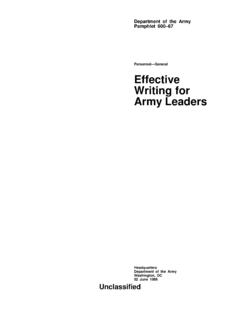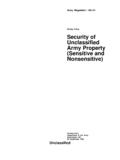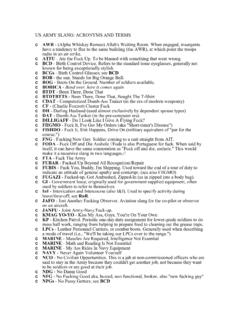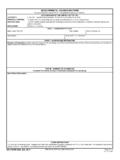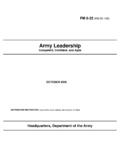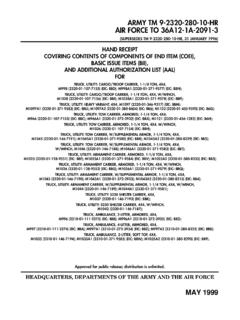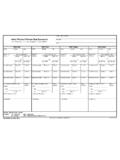Transcription of DELIBERATE RISK ASSESSMENT WORKSHEET
1 DELIBERATE RISK ASSESSMENT WORKSHEET 1. MISSION/TASK DESCRIPTION 2. DATE (DD/MM/YYYY) 3. PREPARED BY a. Name (Last, First, Middle Initial) b. Rank/Grade c. Duty Title/Position d. Unit e. Work Email f. Telephone (DSN/Commercial (Include Area Code)) g. UIC/CIN (as required) h. Training Support/Lesson Plan or OPORD (as required) i. Signature of Preparer Five steps of Risk Management: (1) Identify the hazards (2) Assess the hazards (3) Develop controls & make decisions (4) Implement controls (5) Supervise and evaluate (Step numbers not equal to numbered items on form) 4. SUBTASK/SUBSTEP OF MISSION/TASK How: Who: How: Who: How: Who: How: Who: How: Who: Additional entries for items 5 through 9 are provided on page 2.
2 10. OVERALL RESIDUAL RISK LEVEL (All controls implemented):11. OVERALL SUPERVISION PLAN AND RECOMMENDED COURSE OF ACTION a. Name (Last, First, Middle Initial) b. Rank/Grade c. Duty Title/Position d. Signature of Approval Authority 12. APPROVAL OR DISAPPROVAL OF MISSION OR TASK e. Additional Guidance: DD FORM 2977, JAN 2014 APPROVE DISAPPROVE EXTREMELY HIGH HIGH MEDIUM LOW Page 1 of ____ Pages 5. HAZARD 6. INITIAL RISK 7. CONTROL 9. RESIDUAL RISK LEVEL 8. HOW TO IMPLEMENT/ WHO WILL IMPLEMENT Adobe Professional X LEVEL 4. SUBTASK/SUBSTEP OF MISSION/TASK 5. HAZARD 6. INITIAL RISK LEVEL 7. CONTROL 9. RESIDUAL RISK LEVEL 8. HOW TO IMPLEMENT/ WHO WILL IMPLEMENT DELIBERATE RISK ASSESSMENT WORKSHEET How: Who: How: Who: How: Who: How: Who: How: Who: How: Who: How: Who: How: Who: How: Who: How: Who: How: Who: How: Who: How: Who: DD FORM 2977, JAN 2014 Page ____ of ____ Pages How: Who: 13.
3 RISK ASSESSMENT REVIEW (Required when ASSESSMENT applies to ongoing operations or activities) b. Last Name c. Rank/Grade d. Duty Title/Position e. Signature of Reviewer a. Date 14. FEEDBACK AND LESSONS LEARNED 15. ADDITIONAL COMMENTS OR REMARKS Risk ASSESSMENT Matrix Probability (expected frequency) Frequent: Continuous, regular, or inevitable occurrences Likely: Several or numerous occurrences Occasional: Sporadic or intermittent occurrences Seldom: Infrequent occurrences Unlikely: Possible occurrences but improbable Severity (expected consequence) Catastrophic: Death, unacceptableloss or damage, mission failure, or unit readiness eliminated I Critical: Severe injury, illness, loss, or damage; significantly degraded unit readiness or mission capability II EH L Moderate: Minor injury, illness, loss,or damage; somewhat degraded unit readiness or mission capability III L L Negligible: Minimal injury, loss, or damage.
4 Little or no impact to unit readiness or mission capability IV L L L L Legend: EH extremely high risk H high risk M medium risk L low risk DELIBERATE RISK ASSESSMENT WORKSHEET A B C D E DD FORM 2977, JAN 2014 Page ____ of ____ Pages EH EH H H H H H M M EH M M M 1. Mission/Task Description: Briefly describe the overall Mission or Task for which the DELIBERATE risk ASSESSMENT is being conducted. 9. Residual Risk Level: After controls are implemented, determine resulting probability, severity, and residual risk level. 2. Date (DD/MM/YYYY): Self Explanatory. 10. Overall Risk After Controls are Implemented: Assign an overall residual risk level.
5 This is the highest residual risk level (from block 9). 3. Prepared By: Information provided by the individual conducting the DELIBERATE risk ASSESSMENT for the operation or training . Legend: UIC = Unit Identification Code; CIN = Course ID Number; OPORD = operation order; DSN = defense switched network; COMM = commercial 11. Supervision Plan and Recommended Course of Action: Completed by preparer. Identify specific tasks and levels of responsibility for supervisory personnel and provide the decision authority with a recommend course of action for approval or disapproval based upon the overall risk ASSESSMENT . 4. Sub-task/Sub-Step of Mission/Task: Briefly describe all subtasks or substeps that warrant risk management. 12. Approval/Disapproval of Mission/Task: Risk approval authority approves or disapproves the mission or task based on the overall risk ASSESSMENT , including controls, residual risk level, and supervision plan.
6 Space provided for authority to provide additional guidance; use continuation page if needed. 5. Hazard: Specify hazards related to the subtask in block 4. 13. Risk ASSESSMENT Review: Should be conducted on a regular basis. Reviewers should have sufficient oversight of the mission or activity and controls to provide valid input on changes or adjustments needed. If the residual risk rises above the level already approved, operations should cease until the appropriate approval authority is contacted and approves continued operations. 6. Initial Risk Level: Determine probability and severity. Using the risk ASSESSMENT matrix (page 3), determine level of risk for each hazard specified. probability, severity and associated Risk Level; enter level into column. 14. Feedback and Lessons Learned: Provide specific input on the effectiveness of risk controls and their contribution to mission success or failure.
7 Include recommendations for new or revised controls, practicable solutions, or alternate actions. Submit and brief valid lessons learned as necessary to persons affected. 7. Control: Enter risk mitigation resources/controls identified to abate or reduce risk relevant to the hazard identified in block 5. 15. Additional Comments or Remarks: Preparer provides additional comments, remarks, or information to support the risk ASSESSMENT . If block 15 is used as a continuation of block 14, strike through the block number and title. 8. How to Implement / Who Will Implement: Briefly describe the means of employment for each control ( , OPORD, briefing, rehearsal) and the name of the individual unit or office that has primary responsibility for control implementation. Additional Guidance: Block 4-9 continuance page may be reproduced as necessary for processing of all subtasks/ substeps of the mission/task.
8 If a complete page is not utilized, write NOTHING FOLLOWS on the first unused row, immediately after the final item assessed. Instructions for Completing DD Form 2977, " DELIBERATE Risk ASSESSMENT WORKSHEET " DD FORM 2977 INSTRUCTIONS, JAN 2014
